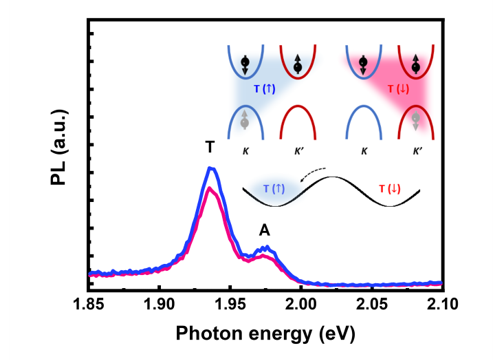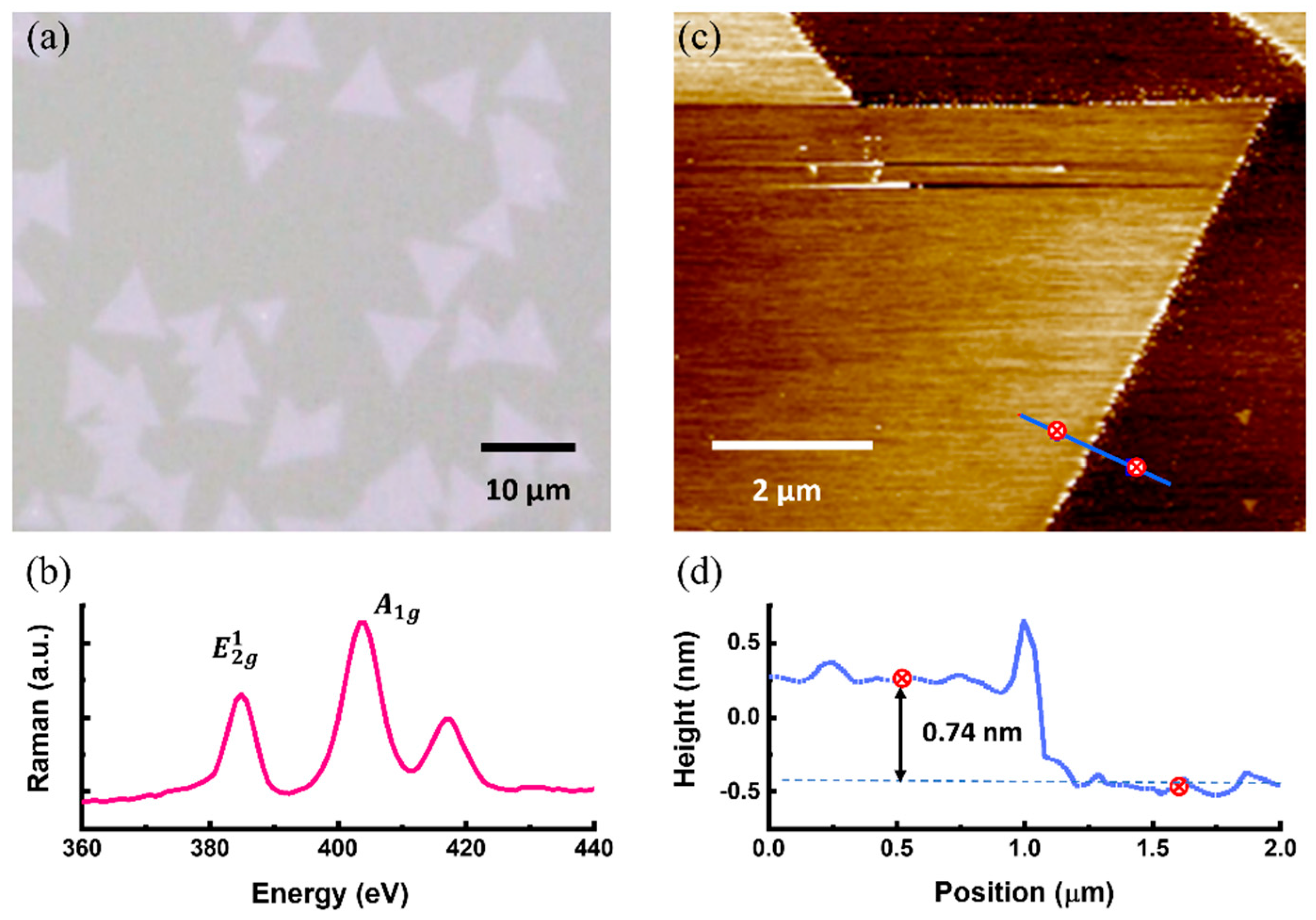Submitted:
18 July 2024
Posted:
18 July 2024
You are already at the latest version
Abstract

Keywords:
1. Introduction
2. Materials and Methods
3. Results
4. Discussion
5. Conclusions
Author Contributions
Funding
Institutional Review Board Statement
Informed Consent Statement
Data Availability Statement
Acknowledgments
Conflicts of Interest
References
- Khatei, J.; Ojha, B.; Samal, D. Valleytronics. Resonance 2023, 28, 537–546. [Google Scholar] [CrossRef]
- Schaibley, J.R.; et al. Valleytronics in 2D materials. Nature Reviews Materials 2016, 1. [Google Scholar] [CrossRef]
- Liu, Y.; et al. Valleytronics in transition metal dichalcogenides materials. Nano Research 2019, 12, 2695–2711. [Google Scholar] [CrossRef]
- Thomas, N.; et al. 2D MoS2: structure, mechanisms, and photocatalytic applications. Materials Today Sustainability 2021, 13. [Google Scholar] [CrossRef]
- Wang, R.; et al. Strategies on Phase Control in Transition Metal Dichalcogenides. Advanced Functional Materials 2018, 28. [Google Scholar] [CrossRef]
- Yang, C.-Y.; et al. Phase-driven magneto-electrical characteristics of single-layer MoS2. Nanoscale 2016, 8, 5627–5633. [Google Scholar] [CrossRef] [PubMed]
- Bussolotti, F.; et al. Roadmap on finding chiral valleys: screening 2D materials for valleytronics. Nano Futures 2018, 2. [Google Scholar] [CrossRef]
- Lu, Z.; et al. Magnetic field mixing and splitting of bright and dark excitons in monolayer MoSe2. 2D Materials 2019, 7. [Google Scholar] [CrossRef]
- Mak, K.F.; He, K.; Shan, J.; Heinz, T.F. Control of valley polarization in monolayer MoS2 by optical helicity. Nat Nanotechnol 2012, 7, 494–498. [Google Scholar] [CrossRef]
- Zhao, S.; et al. Valley manipulation in monolayer transition metal dichalcogenides and their hybrid systems: status and challenges. Rep Prog Phys 2021, 84, 026401. [Google Scholar] [CrossRef]
- Zhu, Z.Y.; Cheng, Y.C.; Schwingenschlögl, U. Giant spin-orbit-induced spin splitting in two-dimensional transition-metal dichalcogenide semiconductors. Physical Review B 2011, 84. [Google Scholar] [CrossRef]
- Huang, L.; et al. Enhanced light-matter interaction in two-dimensional transition metal dichalcogenides. Rep Prog Phys 2022, 85. [Google Scholar] [CrossRef] [PubMed]
- Zeng, H.; Cui, X. An optical spectroscopic study on two-dimensional group-VI transition metal dichalcogenides. Chem Soc Rev 2015, 44, 2629–2642. [Google Scholar] [CrossRef] [PubMed]
- Zeng, H.; Dai, J.; Yao, W.; Xiao, D.; Cui, X. Valley polarization in MoS2 monolayers by optical pumping. Nat Nanotechnol 2012, 7, 490–493. [Google Scholar] [CrossRef] [PubMed]
- Kioseoglou, G.; et al. Valley polarization and intervalley scattering in monolayer MoS2. Applied Physics Letters 2012, 101. [Google Scholar] [CrossRef]
- Aivazian, G.; et al. Magnetic control of valley pseudospin in monolayer WSe2. Nature Physics 2015, 11, 148–152. [Google Scholar] [CrossRef]
- Stier, A.V.; McCreary, K.M.; Jonker, B.T.; Kono, J.; Crooker, S.A. Exciton diamagnetic shifts and valley Zeeman effects in monolayer WS2 and MoS2 to 65 Tesla. Nat Commun 2016, 7, 10643. [Google Scholar] [CrossRef] [PubMed]
- Van der Donck, M.; Zarenia, M.; Peeters, F.M. Strong valley Zeeman effect of dark excitons in monolayer transition metal dichalcogenides in a tilted magnetic field. Physical Review B 2018, 97. [Google Scholar] [CrossRef]
- Zhao, C.; et al. Enhanced valley splitting in monolayer WSe2 due to magnetic exchange field. Nat Nanotechnol 2017, 12, 757–762. [Google Scholar] [CrossRef]
- Lyons, T.P.; et al. Interplay between spin proximity effect and charge-dependent exciton dynamics in MoSe2/CrBr3 van der Waals heterostructures. Nature Communications 2020, 11, 6021. [Google Scholar] [CrossRef]
- Seyler, K.L.; et al. Valley manipulation by optically tuning the magnetic proximity effect in WSe2/CrI3 heterostructures. Nano letters 2018, 18, 3823–3828. [Google Scholar] [CrossRef] [PubMed]
- Chatterji, T.; McIntyre, G.J.; Lindgard, P.A. Antiferromagnetic phase transition and spin correlations in NiO. Physical Review B 2009, 79, 172403. [Google Scholar] [CrossRef]
- Alders, D.; et al. Temperature and thickness dependence of magnetic moments in NiO epitaxial films. Physical Review B 1998, 57, 11623–11631. [Google Scholar] [CrossRef]
- Withanage, S.S.; Lopez, M.; Sameen, W.; Charles, V.; Khondaker, S.I. Elucidation of the growth mechanism of MoS2 during the CVD process. MRS Advances 2019, 4, 581–586. [Google Scholar] [CrossRef]
- Li, T.; et al. Epitaxial growth of wafer-scale molybdenum disulfide semiconductor single crystals on sapphire. Nat Nanotechnol 2021, 16, 1201–1207. [Google Scholar] [CrossRef]
- Zhang, Y.-J.; Luo, Y.-D.; Lin, Y.-H.; Nan, C.-W. Anisotropic ferromagnetic behaviors in highly orientated epitaxial NiO-based thin films. AIP Advances 2015, 5. [Google Scholar] [CrossRef]
- Solovyev, I.V. Exchange interactions and magnetic force theorem. Physical Review B 2021, 103. [Google Scholar] [CrossRef]
- Chakraborty, B.; et al. Symmetry-dependent phonon renormalization in monolayer MoS2 transistor. Physical Review B 2012, 85. [Google Scholar] [CrossRef]
- Wu, L.; et al. Raman scattering investigation of twisted WS2/MoS2 heterostructures: interlayer mechanical coupling versus charge transfer. Nano Research 2021, 14, 2215–2223. [Google Scholar] [CrossRef]
- Yu, Y.; et al. Engineering Substrate Interactions for High Luminescence Efficiency of Transition-Metal Dichalcogenide Monolayers. Advanced Functional Materials 2016, 26, 4733–4739. [Google Scholar] [CrossRef]
- Sharma, M.; Singh, A.; Singh, R. Monolayer MoS2 Transferred on Arbitrary Substrates for Potential Use in Flexible Electronics. ACS Applied Nano Materials 2020, 3, 4445–4453. [Google Scholar] [CrossRef]
- Xu, L.; et al. Analysis of photoluminescence behavior of high-quality single-layer MoS2. Nano Research 2019, 12, 1619–1624. [Google Scholar] [CrossRef]
- Pei, J.; et al. Exciton and trion dynamics in bilayer MoS2. Small 2015, 11, 6384–6390. [Google Scholar] [CrossRef] [PubMed]
- Zhang, Y.; et al. Controllable Magnetic Proximity Effect and Charge Transfer in 2D Semiconductor and Double-Layered Perovskite Manganese Oxide van der Waals Heterostructure. Adv Mater 2020, 32, e2003501. [Google Scholar] [CrossRef] [PubMed]




Disclaimer/Publisher’s Note: The statements, opinions and data contained in all publications are solely those of the individual author(s) and contributor(s) and not of MDPI and/or the editor(s). MDPI and/or the editor(s) disclaim responsibility for any injury to people or property resulting from any ideas, methods, instructions or products referred to in the content. |
© 2024 by the authors. Licensee MDPI, Basel, Switzerland. This article is an open access article distributed under the terms and conditions of the Creative Commons Attribution (CC BY) license (http://creativecommons.org/licenses/by/4.0/).




